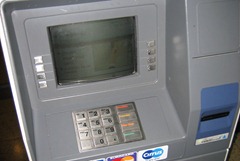In all of our travels, we have never once used traveler checks. No matter where we go in the world, we’ve always been able to find an ATM. We have a well practiced ritual of hunting down an ATM as the first thing we do in any country. The only place we weren’t able to find an ATM directly in the airport was in Rarotonga (Cook Islands) where the ATM was a 5 minute walk down the road. Arriving by train can be a little more difficult (as we found in Vietnam in Hanoi, where we had a 20 minute trek with our packs from the station to find a working ATM).
Fees
The fees for withdrawing from an ATM can be quite steep – although our bank refunds us a portion of that. However, the currency exchange rate is favorable – there is generally no markup over the standard bank rate, unlike the 1-3% that credit cards will charge.
The Different ATM Networks
Although it’s really not an issue in the US, there are a couple of major international ATM networks: Plus, Star, and Cirrus. For this reason we always carry a couple of different bank cards around. In addition, daily limits can be fairly low – and in expensive countries, to avoid having to hunt down an ATM every other day, it’s nice to be able to take out a larger sum (and split up between several backpacks / money pouches, of course!) .
Cash advances with a credit card
If none of our bank cards work, we have used our credit cards for cash advances. This has a couple of disadvantages. The currency exchange rate is generally not as favorable, and the credit card company starts charging interest from the minute you withdraw the funds (at an extremely high interest rate, generally). However, this technique has saved us a couple of times – make sure to know the PIN for your credit cards before you leave. Once upon a time, we used a trick of over-paying our credit card before we left and withdrawing from that balance. When we moved to the US however, we found that the credit card companies had wised up to this and will write you a check to wipe out any positive balance before letting you use it for advances. This technique might still work if you hold a Canadian credit card.
USD as a Backup
We always carry at least $100 US everywhere we go. This is our "emergency cash", and can be very helpful – especially on arrival at the airport for any expenses before an ATM is found. The US Dollar is accepted almost everywhere.
And finally, the closest we’ve come to running out of money…
In Tahiti, the only bank machine we could reliably find that would work with international bank cards was in the airport – and even then, it would only work with a credit card. When we arrived, we didn’t withdraw much money, since we didn’t want to pay the hefty cash advance fees. We assumed that downtown Papeete would have international-friendly bank machines. Not so much! We ended up deliberately overpaying for a souvenir at a craft market, and getting the seller to give us cash back – which got us through to when we were able to get back to the airport to use the charmed international machine. (this is technically illegal, but she was really kind!) It turns out that the machines in Tahiti often depend on a microchip embedded in the card itself, and since US/Canadian cards don’t have that, they don’t work. (We used to have the same problem in France – the gas stations don’t have attendants on the weekend, and non-chipped credit cards didn’t work!)
In general, a couple of ATM Cards, a Visa/Mastecard, and as a last resort a bit of USD has always guaranteed we’ve never had any troubles getting local currency.
How We Get Money When We Travel – And Why We Never Used Traveler Checks
Social Share
One Comment
Leave a Reply Cancel reply
Recent Posts
Nov 06, 2015
Oct 09, 2015
Sep 30, 2015
Videos
Recent Posts
- How to spoil yourself silly on a beach vacation
- Old, almost free tech bringing traveling families together
- Losing our wheels in Munich
- A disgusting car seat awaits you in Munich!
- Alphaberry by B-Toys – An electronic singing toy we love to travel with!
- Fabulous indoor – and outdoor – playground in Siauliai, Lithuania





I agree. Traveler Checks may be OK 20 yeas ago before technology took over. I am sure that traveler’s checks are a dying business just like your regular paper personal checks.
[Reply]